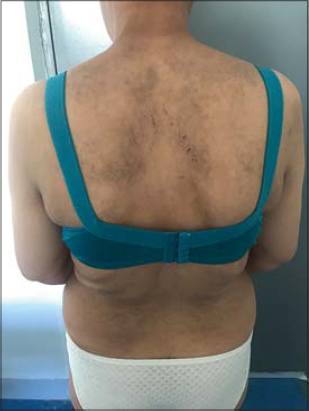Association of alopecia areata and lichen planus pigmentosus
Selma El Kadiri , Hanane Baybay, Rhizlane Chaoui, Zakia Douhi, Sara Elloudi, Fatima Zahra Mernissi
, Hanane Baybay, Rhizlane Chaoui, Zakia Douhi, Sara Elloudi, Fatima Zahra Mernissi
Departement of Dermatology, CHU Hassan II, Fez, Morocco
Corresponding author: Dr. Selma El Kadiri, E-mail: elkadiri-s@hotmail.com
Submission: 16.01.2020; Acceptance: 21.02.2020
DOI: 10.7241/ourd.2020e.13
Cite this article: El Kadiri S, Bay Bay H, Chaoui R, Douhi Z, Elloudi S, Mernissi FZ. Association of alopecia areata and lichen planus pigmentosus. Our Dermatol Online. 2020;11(e):e13.1-e13.2.
Citation tools:
Copyright information
© Our Dermatology Online 2020. No commercial re-use. See rights and permissions. Published by Our Dermatology Online.
Sir,
Lichen planus pigmentosus is a a rare variant of lichen planus. It is characterized by acquired dark brown to gray macular pigmentation on sun-exposed areas commonly found in dark-skinned phototype. Here we report a case of association of alopecia areata and lichen planus pigmentosus.
A 35-year-old woman he patient presented with multiple alopecic scalp plaques progressing for 1 year towards total scalp alopecia. The evolution was marked by hypopigmented hair regrowth maintained for years (Fig. 1). On dermatological examination, the patient presented multiple pruriginous grayish pigmented macules of the trunk (Fig. 2). The dermoscopy objectified the presence of multiple dots and globules) surrounding perifollicular openings. Histopathological examination of biopsy specimens showed vacuolization of basal cell layer associated with pigmented incontinence and keratinocytic apoptosis. Our patient was treated with association of corticoids and methotrexate. Although the association between lichen planus and alopecia areata is well known, a similar association in LPP patients has not been established before. In their pilot study seeking for LPP association, LPP was frequently associated to diabetis, hypothyroidism, SAAPL, Gougerot Sjogren, Crohn’s disease and ulcerative colitis [1]. These results are suggestive of the autoimmune pathogenesis of LPP. We report a new association of lichen planus pigmentosus and alopecia areata corroborating this hypothesis.
 |
Figure 1. Hypopigmented hair regrowth of totalis alopecia areata. |
 |
Figure 2. Multiples grayish macules of the trunk. |
Consent
The examination of the patient was conducted according to the Declaration of Helsinki principles.
The authors certify that they have obtained all appropriate patient consent forms. In the form the patient(s) has/have given his/her/their consent for his/her/their images and other clinical information to be reported in the journal. The patients understand that their names and initials will not be published and due efforts will be made to conceal their identity, but anonymity cannot be guaranteed.
REFERENCES
1. Youssef M, Lahouel I, Korbi M, Soua Y, Marmouch H, Akkari H, et al. Lichen planus pigmentosus and association with autoimmune diseases:A case–control study. Our Dermatol Online. 2019;10:125-30.
Notes
Source of Support: Nil
Conflict of Interest: None declared
Request permissions
If you wish to reuse any or all of this article please use the e-mail (brzezoo77@yahoo.com) to contact with publisher.
| Related Articles | Search Authors in |
|
 http://orcid.org/000-0003-3455-3810 http://orcid.org/000-0003-3455-3810 |



Comments are closed.